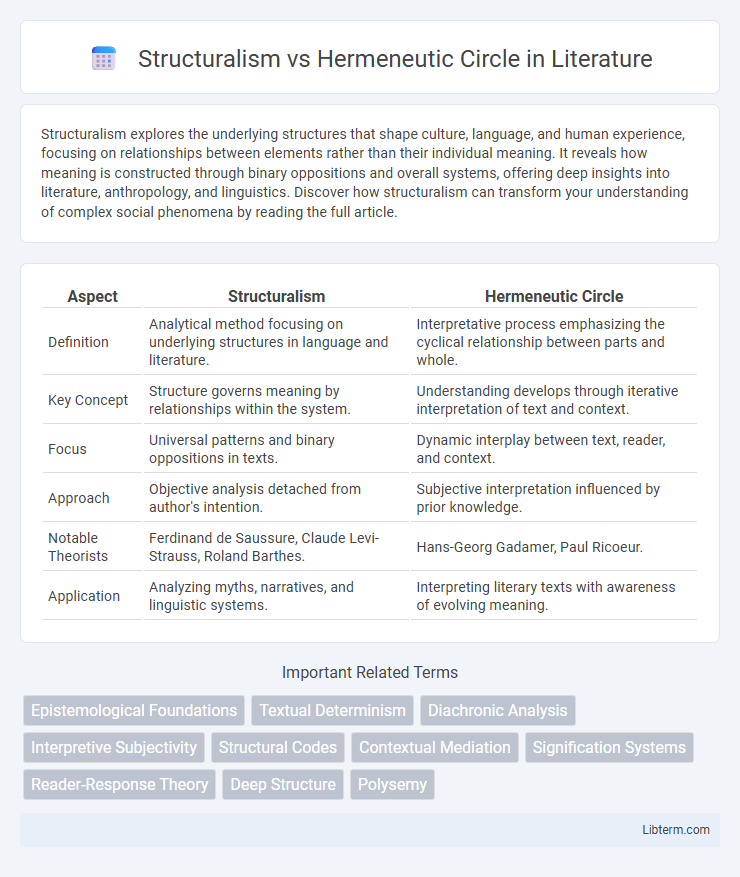Structuralism explores the underlying structures that shape culture, language, and human experience, focusing on relationships between elements rather than their individual meaning. It reveals how meaning is constructed through binary oppositions and overall systems, offering deep insights into literature, anthropology, and linguistics. Discover how structuralism can transform your understanding of complex social phenomena by reading the full article.
Table of Comparison
| Aspect | Structuralism | Hermeneutic Circle |
|---|---|---|
| Definition | Analytical method focusing on underlying structures in language and literature. | Interpretative process emphasizing the cyclical relationship between parts and whole. |
| Key Concept | Structure governs meaning by relationships within the system. | Understanding develops through iterative interpretation of text and context. |
| Focus | Universal patterns and binary oppositions in texts. | Dynamic interplay between text, reader, and context. |
| Approach | Objective analysis detached from author's intention. | Subjective interpretation influenced by prior knowledge. |
| Notable Theorists | Ferdinand de Saussure, Claude Levi-Strauss, Roland Barthes. | Hans-Georg Gadamer, Paul Ricoeur. |
| Application | Analyzing myths, narratives, and linguistic systems. | Interpreting literary texts with awareness of evolving meaning. |
Introduction to Structuralism and the Hermeneutic Circle
Structuralism analyzes cultural and literary phenomena by identifying underlying structures that shape meaning, emphasizing patterns such as language, myths, and social systems. The Hermeneutic Circle, central to interpretive methodologies, involves understanding a text or phenomenon through an iterative process between its parts and the whole, highlighting the dynamic nature of interpretation. Both approaches prioritize the interrelation of elements to reveal deeper meanings but differ by structuralism's focus on systemic frameworks and the Hermeneutic Circle's focus on contextual understanding and meaning-making processes.
Origins and Historical Development
Structuralism emerged in the early 20th century, primarily influenced by linguist Ferdinand de Saussure, who emphasized language as a system of interrelated elements. The Hermeneutic Circle, rooted in ancient philosophical traditions but formalized by 19th-century thinkers like Friedrich Schleiermacher and Wilhelm Dilthey, centers on the iterative process of understanding texts through the interplay between whole and parts. Both frameworks developed as foundational methodologies in the humanities, with Structuralism shaping semiotics and anthropology, while the Hermeneutic Circle influenced literary theory and interpretive philosophy.
Core Principles of Structuralism
Structuralism centers on analyzing cultural phenomena through underlying structures such as language, mythology, and social systems, positing that meaning arises from the relationships between elements within these systems. It relies on binary oppositions and universal patterns to uncover hidden rules governing human behavior and cognition. Unlike the Hermeneutic Circle, which emphasizes iterative interpretation of texts and contexts, Structuralism seeks objective frameworks to decode meaning systematically.
Understanding the Hermeneutic Circle
The Hermeneutic Circle emphasizes the iterative process of understanding a text by continuously relating its parts to the whole and vice versa, highlighting the dynamic interaction between context and interpretation. Structuralism, in contrast, seeks to analyze the underlying structures and systems within a text, viewing meaning as derived from these stable relationships rather than interpretive cycles. Understanding the Hermeneutic Circle involves recognizing how preconceptions and accumulated insights shape comprehension, making interpretation a constantly evolving dialogue between reader and text.
Key Theorists and Influential Works
Structuralism, pioneered by Ferdinand de Saussure with his seminal work "Course in General Linguistics," emphasizes underlying structures in language and culture, while Claude Levi-Strauss extended these ideas to anthropology through "The Savage Mind." The Hermeneutic Circle, central to the philosophy of Hans-Georg Gadamer, especially in "Truth and Method," highlights the process of interpretation where understanding is achieved by moving between the parts and the whole of a text. Key theorists such as Paul Ricoeur further developed the Hermeneutic approach, integrating phenomenology and interpretation in works like "Interpretation Theory.
Methodological Differences
Structuralism employs a systematic methodology analyzing underlying structures within texts, emphasizing language systems and binary oppositions to uncover meaning. In contrast, the Hermeneutic Circle relies on iterative interpretation, where understanding the whole text depends on its parts and vice versa, highlighting the dynamic and contextual nature of meaning. Structuralism seeks objective patterns via linguistic frameworks, while the Hermeneutic Circle embraces subjective, evolving comprehension through continuous dialogue between reader and text.
Applications in Literary and Cultural Analysis
Structuralism analyzes literary and cultural texts by identifying underlying systems, structures, and codes, enabling scholars to uncover universal patterns and relationships within narratives and symbols. The Hermeneutic Circle emphasizes the interpretive process, where understanding a text emerges from the dynamic interaction between its parts and the whole, enriching the analysis of meanings shaped by historical and cultural contexts. In literary and cultural analysis, structuralism offers tools for dissecting formal elements, while the Hermeneutic Circle facilitates deeper interpretation through contextual engagement and reflexive reading.
Epistemological Implications
Structuralism emphasizes knowledge as a system of underlying structures shaping meaning, suggesting objective analysis detached from individual interpretation. The Hermeneutic Circle highlights the interdependence of the part and whole in understanding texts, emphasizing subjective, iterative interpretation rooted in context and preconceptions. Epistemologically, Structuralism aligns with positivist certainty, while the Hermeneutic Circle embraces interpretive fluidity and the evolving nature of meaning.
Critiques and Contemporary Relevance
Structuralism faces critiques for its rigid framework that often overlooks individual context and subjective interpretation, limiting its applicability to dynamic texts and social phenomena. The hermeneutic circle emphasizes the interdependence of parts and wholes in interpretation, addressing the fluidity of meaning but criticized for potential circular reasoning and lack of objective criteria. Contemporary relevance lies in integrating structuralist patterns with hermeneutic sensitivity, enabling nuanced analysis in disciplines like literary theory, anthropology, and cognitive science.
Conclusion: Bridging Structure and Interpretation
Structuralism and the Hermeneutic Circle offer complementary insights by emphasizing the interplay between underlying structures and interpretative processes in understanding texts and phenomena. Structuralism identifies fixed patterns that shape meaning, while the Hermeneutic Circle highlights the dynamic relationship between parts and wholes in interpretation. Bridging these approaches enhances comprehension by integrating structural analysis with continuous contextual interpretation, enabling deeper insight into complex cultural and literary systems.
Structuralism Infographic

 libterm.com
libterm.com